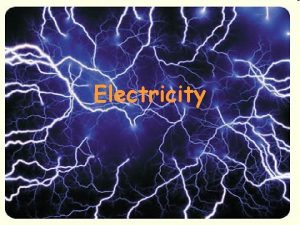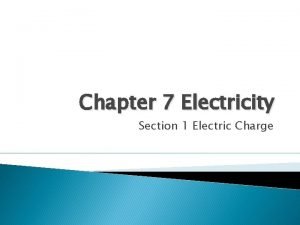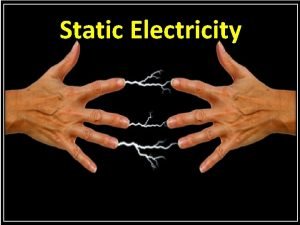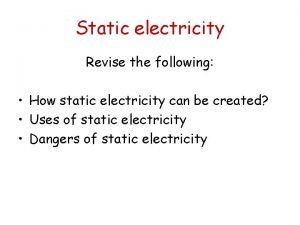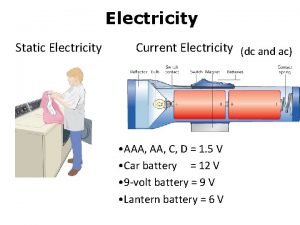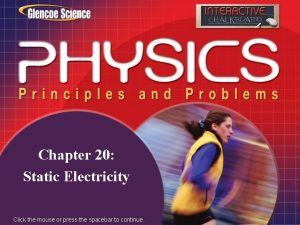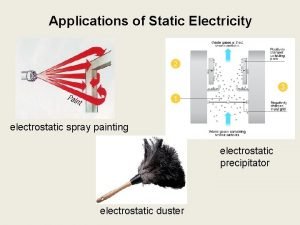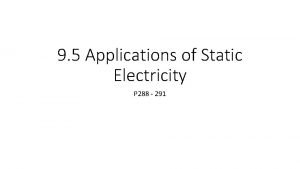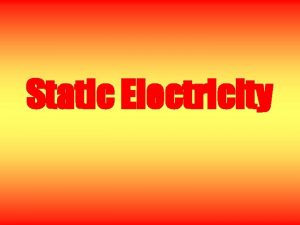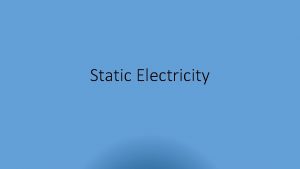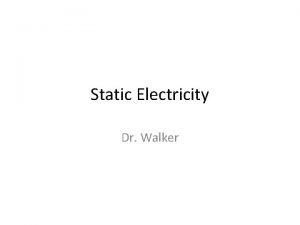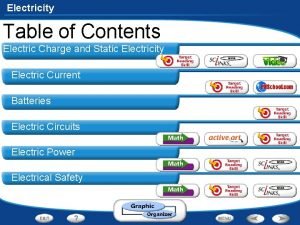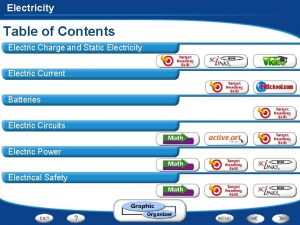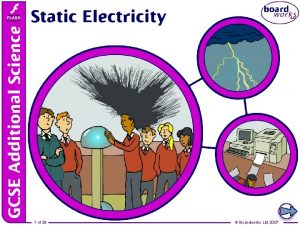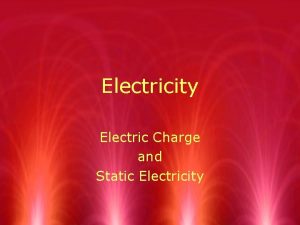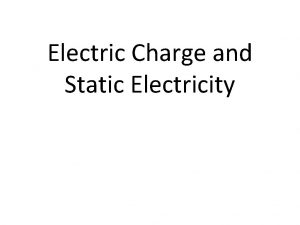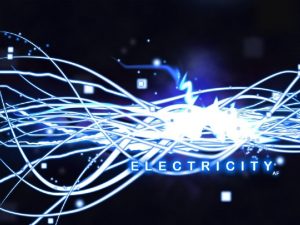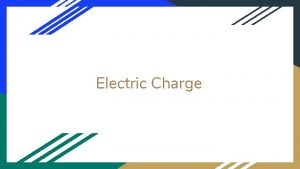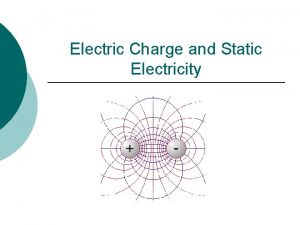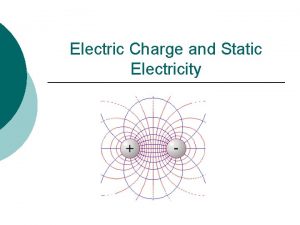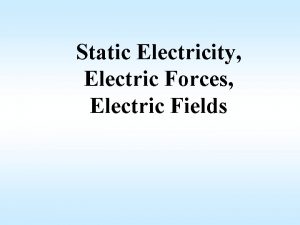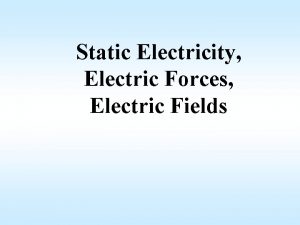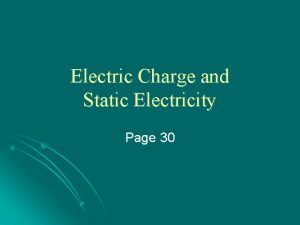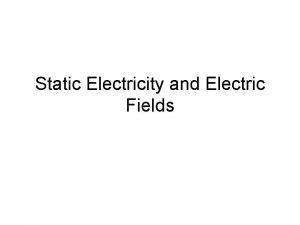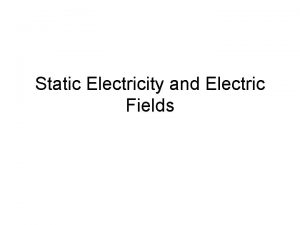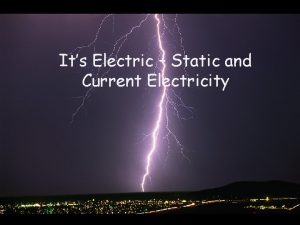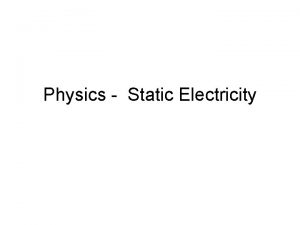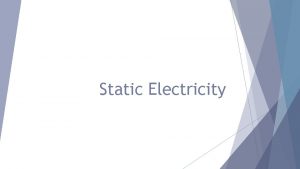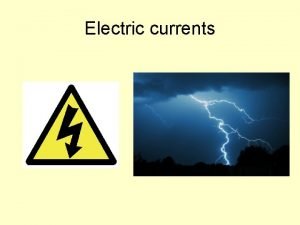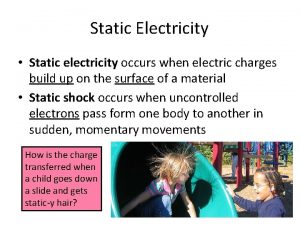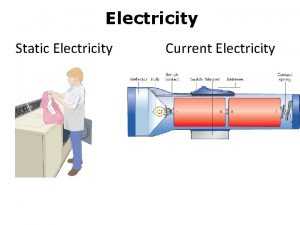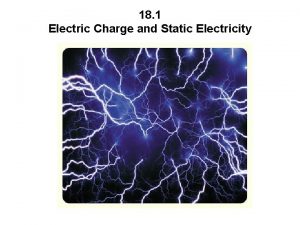Electric Charge and Static Electricity Page 30 Essential

























- Slides: 25

Electric Charge and Static Electricity Page 30

Essential questions l 1. What is the connection between parts of an atom and charged particles? l 2. What characteristics define electric currents?


ATOMS and charge l Atoms ARE MADE OF PARTICLES: l Protons are LOCATED ____ l Protons have a ______ charge l Neutrons are located _______ l Neutrons have a _____ charge l Electrons are located _______ l Electrons have a _____ charge

Review time Electrons are found inside the nucleus. True or false

Correct answer is false

Law of electric charge Electric forces are created between all electric charges. l Because there are two kinds of charge (positive and negative) the electrical force between charges can attract or repel. l

Electric force l l Is the force between charged objects. Strength is determined by 2 factors: l The size of the charges. l Distance between charges

Electric field l l l Is a region around a charged particle that can exert a force on another charged particle. Objects become charged because the atoms in the objects can gain or lose electrons. If the atoms lose electrons the object becomes (+). If the atoms gain electrons the object becomes (-).

How objects become charged l l l Friction-rubbing of 2 objects together Conduction- occurs when electrons are transferred from 1 object to another by direct contact. Induction- occurs when an uncharged object are rearranged without direct contact with a charged object.

Conservation of charge l l l when you charge objects by any method, no charges are created or destroyed. Electrons simply move from 1 atom to another. This produces objects or regions with different charges. Since charges are not created or destroyed, charge is said to be conserved.

Detecting charge l To determine charge use an electroscope.

Moving charges 2 groups- conductors & insulators. l Conductor- is a material in which charges can move easily. Mainly metals. l Examples- copper, silver, aluminum, and mercury l Water is a conductor l

insulators Insulator- is a material in which charges cannot move easily. l Electrons are tightly bound to atoms. l Examples- plastic, rubber, glass, wood, and air. l

Static electricity S. e. – is the buildup of electricity charges on an object. l If an object is static it is not moving. l Electric discharge – the loss of static electricity. l

lightning l l Example of electric discharge Figure 6 page 479

LIGHTNING Lighting rod- is a pointed rod connected to the ground by a wire. l Lightning rods are “grounded” meaning they are in contact with earth. l Earth absorbs charge so no damage is done to buildings. l

Things to remember l Charge is a physical property. Objects with a (+) or (-) charge exert a force on other charged objects l l Lightning and the shock you receive from a doorknob are example of electric discharge. What is a conductor/ insulator?

Electrical energy Section 2

l l l Electrical energy- the energy of electric charges. Electric current- flow of electrical charges. One common way to produce electric current is through chemical reactions in a battery. l l Cell- is a device that produces an electrical current by converting chemical energy to electrical energy. Battery- converts chemical energy into electrical energy and is made of several cells.

Parts of a cell l Every cell contains a mixture of chemicals that conducts a current. l l The mixture is called an electrolyte. Chemical reactions in the electrolyte convert chemical energy into electrical energy.

Parts…. . l Electrode- is the part of a cell through which charges enter or exit.

Cell types Cell are divided into 2 groups. l Wet cells- contain liquid electrolytes. (example car battery) l Dry cells- contain electrolytes that are solids or paste-like. (ex. Batteries) l

Terms Potential difference- energy per unit charge; specifically, the difference in energy per unit charge as a charge moves between 2 points in an electric circuit. l Measured in volts l

l Photocell- is the part of a solar panel that converts light into electrical energy. l Thermocouples- used to monitor the temperature of car engines, furnaces, and ovens.
 Static electricity and current electricity
Static electricity and current electricity Electricity n
Electricity n Electricity and magnetism vocabulary
Electricity and magnetism vocabulary Chapter 6 section 1 electric charge worksheet answers
Chapter 6 section 1 electric charge worksheet answers Electricity section 1 electric charge
Electricity section 1 electric charge Electricity section 1 electric charge
Electricity section 1 electric charge Difference between charge and electric charge
Difference between charge and electric charge Difference between static and current electricity
Difference between static and current electricity Chapter 21 electric charge and electric field
Chapter 21 electric charge and electric field Chapter 21 electric charge and electric field
Chapter 21 electric charge and electric field K constant unit
K constant unit Dc o/d per item charge
Dc o/d per item charge Electricity flow
Electricity flow How does a photocopier work using static electricity
How does a photocopier work using static electricity Bill nye electricity worksheet
Bill nye electricity worksheet What is electricity made of
What is electricity made of Ohm's law unit
Ohm's law unit Static electricity chapter 20 answers
Static electricity chapter 20 answers How is static electricity used in spray painting
How is static electricity used in spray painting Static electricity painting
Static electricity painting Static electricity.
Static electricity. Static electricity examples
Static electricity examples What is triboelectric series
What is triboelectric series Static electricity table
Static electricity table Electric current graphic organizer
Electric current graphic organizer Static electricity summary
Static electricity summary




